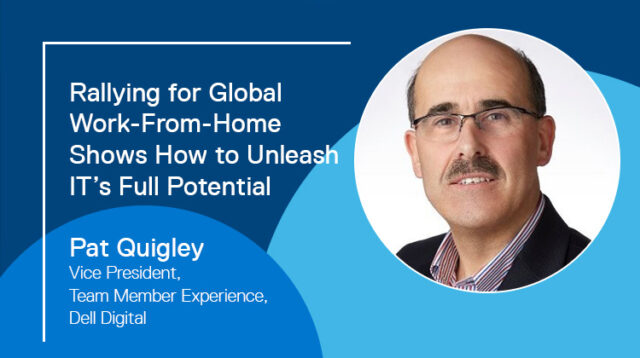Shifting 150,000 employees to working productively from home in a matter of weeks in early March was an incredible feat for our IT organization. Even more amazing, however, are the insights we gained from that success that will now help shape the future of how we provide IT to team members at Dell Technologies.
Unleashing our IT capabilities in such a targeted way in that short period of time showed the potential of our organization to strip away the excess bureaucracy that finds its way into our world and really think about how to unlock our full capabilities.
As we moved our organization to work primarily remotely, it was incredible to watch. Our IT organization didn’t need a lot of program oversight. People just knew what to do and got on and did it, versus our traditional IT program office approach.
If we thought about doing what we did in the traditional way, it would probably have taken years and multi-millions of dollars in terms of program activity- for example, moving 30,000 contact center agents to work from home. Instead, working directly with our business partners, we ramped up our network, infrastructure and security in a matter of days.
A key focus for Dell Digital, Dell’s IT organization, going forward is to remove friction from people’s lives so they can move seamlessly between personal, social and professional activities regardless of where they are working. As we pursue that goal, we will use the lessons we learned from responding to the global IT shift, including striving for a laser-focused, non-bureaucratic and more flexible approach to harness our true potential.
A Direct, Dynamic, Committee-free Approach
Our teams could act swiftly supported by the foundation that Dell Technologies already had in place to enable team members work from anywhere, including a ten-year-old program called the Connected Workplace, letting workers choose the work style that best fulfills their needs on the job and in life in a highly mobile, collaborative, and flexible work setting.
Dell Digital began to focus on beefing up inventory of PCs, headsets, monitors and peripherals in February after watching concerns rise in China and enabling employees there to work from home. Our biggest focus was to ensure we would have enough devices and peripherals for team members to shift to working from home on a global basis. We began working with our supply chain and set deliveries in motion.
It was a proactive risk that paid off. By March 10, with the decision to go completely remote, we already had 95 percent of the inventory we needed and were able to fill the gaps in small pockets here and there.
Another thing that helped smooth the work-from-home push was that fact that we had a strong relationship between our IT site services regional leaders and business unit leaders and partners already in place. That meant we could seamlessly integrate into business continuity and action plans around the mobile workforce.
It was very a direct, dynamic and on-the-ground conversation. It wasn’t working through committees of people that handed things off to other committees. That was hugely important because there was no differentiation between IT and the business unit team members. It was working shoulder-to-shoulder together to ensure our teams were safe and could be productive from home.
Dell Digital Team Member Experience (TMX) has been driving a mobile first approach to IT services for the past two years, honing employee personas to standardize how team members are provisioned with the right devices, technology, applications and access rights to let them work from anywhere.
As our world continues to go through unprecedented changes, we were able to successfully continue our onboarding process, servicing close to 7,000 new hires seamlessly.
Underlying our ability to deliver productivity to an expanded remote workforce was the fact that we had built out our network capability through the roll out of a modern SD-WAN network, leveraging VeloCloud, and scaled our VPN to accommodate the shift to working from home. It also improved the performance of our software-as-a-service offerings, including collaboration tools like Zoom and Teams, to improve remote productivity.
Newfound Flexibility for the TMX Team
Among the many things we learned from this unprecedented workforce shift is the value of flexibly aligning our resources with where the work is, as well as cross-training team members to support that flexibility.
As our team members hit, TMX closed our popular Tech Central locations, where tech experts provided site-specific, in-person technical help around the globe, and sent our 200 team members home. They became a digital extension of our Service Desk and engineering support teams.
This allowed us to keep them safe and keep them productive which benefitted us and our team members and hopefully reduce their anxiety and concern about having to work from home. We aligned team members with remote tech services work that was available, primarily on the service desk.
We quickly started to use them for other program work as well, like upgrading our SharePoint environment and Skype to Teams initiatives, using it as an opportunity to increase their skills with added training.
Prior to this time, we had traditionally aligned work to the resources in their technical workstreams. In adapting to the work-from-home demands, we learned that to align available resources to where the work is more efficient. It also helps us with our ongoing efforts to remove silos and cross-skill our team members in an increasingly software-defined environment.
The cross-training on support functions has given rise to a new vision for TMX roles. Instead of having a service desk person versus an on-site person versus a SharePoint engineer, we are moving toward two more versatile roles—a TMX engineer and a TMX support person who can move flexibly between products.
As our Dell team members return to site, we are reopening some of our Tech Central locations and site technicians are returning to campus to provide essential on-site services. The majority of our team members still working from home and are supported by our service desk and Dell Services ProSupport for hardware break-support as needed.
A New Way of Communicating
Another lesson we learned in this unique time is the value of being innovative in communicating with our employees. One of the most important things we had to do as workers shifted to home was to enable the company to keep our team members informed regarding the transition.
We wanted to make sure team members knew what the company’s positioning was on the health concerns, as well as being aware of working from home best practices, collaboration tools, even making sure they took breaks to avoid burnout. And we wanted our communications to be delivered in a more direct way than the traditional use of email and intranet.
We decided to use a VMware Workspace ONE capability that allowed us to broadcast regular short messages to any device. We used pop ups for about six weeks as a direct and flexible way to help deliver corporate messages.
Looking Ahead: Bridging Remote and On-campus
As I look ahead to the future, I think it is a fair assumption that more people will be working remotely than in the past, as well as working in a more flexible way. Dell Digital, in conjunction with our business partners, will leverage the flexibility and focus we gained during this rapid transition to deliver the capabilities to bridge the gap between on-site and remote services to enable our team members to have the flexibility to be productive and be their best anywhere, anytime.
Find out more about how Dell is reimaging how it does business at Dell Technologies: Our Digital Transformation.


